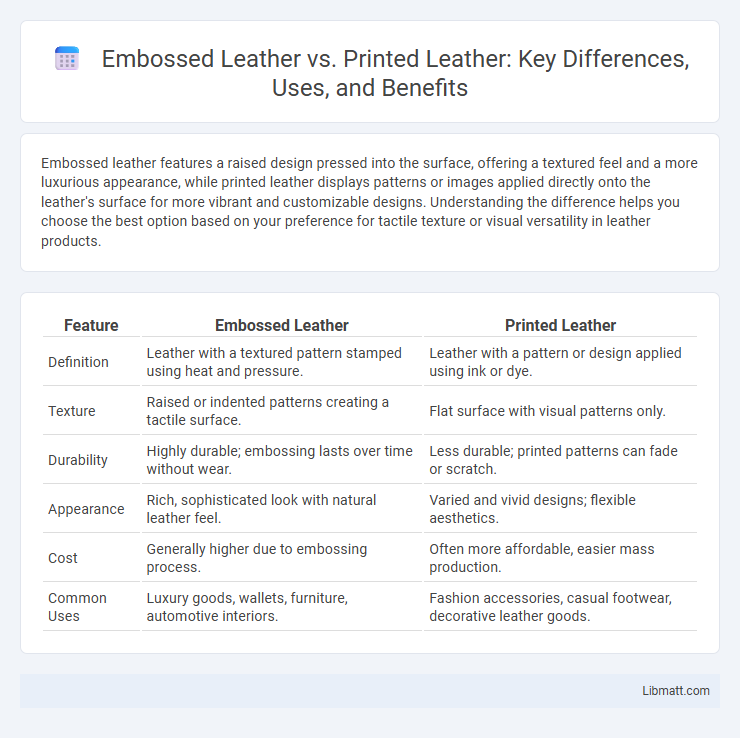Embossed leather features a raised design pressed into the surface, offering a textured feel and a more luxurious appearance, while printed leather displays patterns or images applied directly onto the leather's surface for more vibrant and customizable designs. Understanding the difference helps you choose the best option based on your preference for tactile texture or visual versatility in leather products.
Table of Comparison
| Feature | Embossed Leather | Printed Leather |
|---|---|---|
| Definition | Leather with a textured pattern stamped using heat and pressure. | Leather with a pattern or design applied using ink or dye. |
| Texture | Raised or indented patterns creating a tactile surface. | Flat surface with visual patterns only. |
| Durability | Highly durable; embossing lasts over time without wear. | Less durable; printed patterns can fade or scratch. |
| Appearance | Rich, sophisticated look with natural leather feel. | Varied and vivid designs; flexible aesthetics. |
| Cost | Generally higher due to embossing process. | Often more affordable, easier mass production. |
| Common Uses | Luxury goods, wallets, furniture, automotive interiors. | Fashion accessories, casual footwear, decorative leather goods. |
Introduction to Embossed and Printed Leather
Embossed leather features a raised pattern created by pressing designs into the leather surface using heat and pressure, giving it a textured, three-dimensional look that enhances durability and aesthetic appeal. Printed leather, on the other hand, involves applying ink or dye onto the leather's surface to produce detailed images or patterns without altering the texture, allowing for vibrant and versatile design options. Understanding the distinct characteristics of embossed versus printed leather enables you to choose the best material for your style and functional needs.
Defining Embossed Leather
Embossed leather is defined by its textured surface created through heat and pressure using engraved plates that imprint patterns or designs onto the leather. This technique enhances the material's aesthetic appeal and durability by adding a raised or recessed pattern that mimics natural textures such as alligator or crocodile skin. Unlike printed leather, which applies ink or paint to create surface images, embossed leather physically alters the leather's grain, providing a tactile and long-lasting finish.
Understanding Printed Leather
Printed leather features designs or patterns applied directly onto the leather surface using techniques such as digital printing or screen printing, offering vibrant colors and intricate details that embossed leather cannot achieve. This method preserves the leather's natural texture while allowing for customizable and precise artwork, making it ideal for fashion and decorative applications. Understanding printed leather helps you select materials that combine both aesthetic versatility and the authentic feel of genuine leather.
Differences in Manufacturing Techniques
Embossed leather is created by pressing a patterned plate into the leather surface using heat and pressure, which raises the design to give a textured, three-dimensional effect. Printed leather involves applying inks or dyes directly onto the top layer of the leather using methods like screen printing or digital printing to create flat, colorful designs. Understanding these manufacturing techniques helps you choose between the tactile depth of embossed leather and the versatile pattern options of printed leather.
Visual and Textural Distinctions
Embossed leather features raised patterns created by pressing designs into the hide, resulting in a textured surface with depth and tactile variation, while printed leather displays flat, two-dimensional images applied through ink or dye, lacking physical texture. The visual distinction lies in embossed leather's three-dimensional relief, enhancing light and shadow interplay, in contrast to printed leather's smooth, uniform appearance with vibrant color details. Texturally, embossed leather offers a pronounced, tactile experience that emphasizes durability and craftsmanship, whereas printed leather emphasizes visual aesthetics without altering the leather's natural feel.
Durability and Longevity Comparison
Embossed leather features raised patterns pressed into the surface, enhancing its resistance to scratches and wear, which significantly improves its durability and longevity compared to printed leather. Printed leather, while visually versatile due to direct application of designs onto the surface, tends to fade and peel over time, reducing its lifespan. The embossed technique embeds texture into the leather, offering long-lasting aesthetic appeal and structural integrity that printed leather often lacks.
Common Applications and Uses
Embossed leather is commonly used in luxury handbags, wallets, and upholstery where texture and a premium tactile experience are desired, often mimicking exotic patterns like crocodile or snake skin. Printed leather finds frequent application in fashion apparel, automotive interiors, and custom accessories, allowing for intricate designs, logos, or patterns that enhance visual appeal without altering the surface texture. Both materials serve distinct purposes: embossed leather emphasizes texture and durability, while printed leather prioritizes detailed, customizable aesthetics.
Aesthetic Appeal and Design Flexibility
Embossed leather offers a rich, textured aesthetic that enhances the tactile experience and adds depth to your design, while printed leather provides vibrant, intricate visuals with limitless color and pattern options. Embossing creates a sense of luxury and durability by physically altering the leather surface, making it ideal for classic or sophisticated styles. Printed leather allows maximum design flexibility, easily adapting to contemporary trends with precise color matching and detailed artwork.
Cost and Value Analysis
Embossed leather generally costs more upfront than printed leather due to the specialized stamping process that creates a textured, durable design. Printed leather offers a cost-effective alternative with greater design versatility but may lack the depth and longevity, affecting long-term value. Your choice depends on balancing immediate budget constraints with the desired durability and aesthetic appeal.
Choosing Between Embossed and Printed Leather
Choosing between embossed and printed leather depends on the desired texture and durability; embossed leather features raised patterns created by stamping, offering a tactile, three-dimensional effect that enhances wear resistance. Printed leather provides vibrant colors and intricate designs applied on the surface, allowing greater versatility in customization but may be less durable over time. Considering the application, embossed leather suits luxury goods requiring subtle elegance and longevity, while printed leather excels in fashion items where visual impact and varied patterns are prioritized.
Embossed leather vs printed leather Infographic

 libmatt.com
libmatt.com